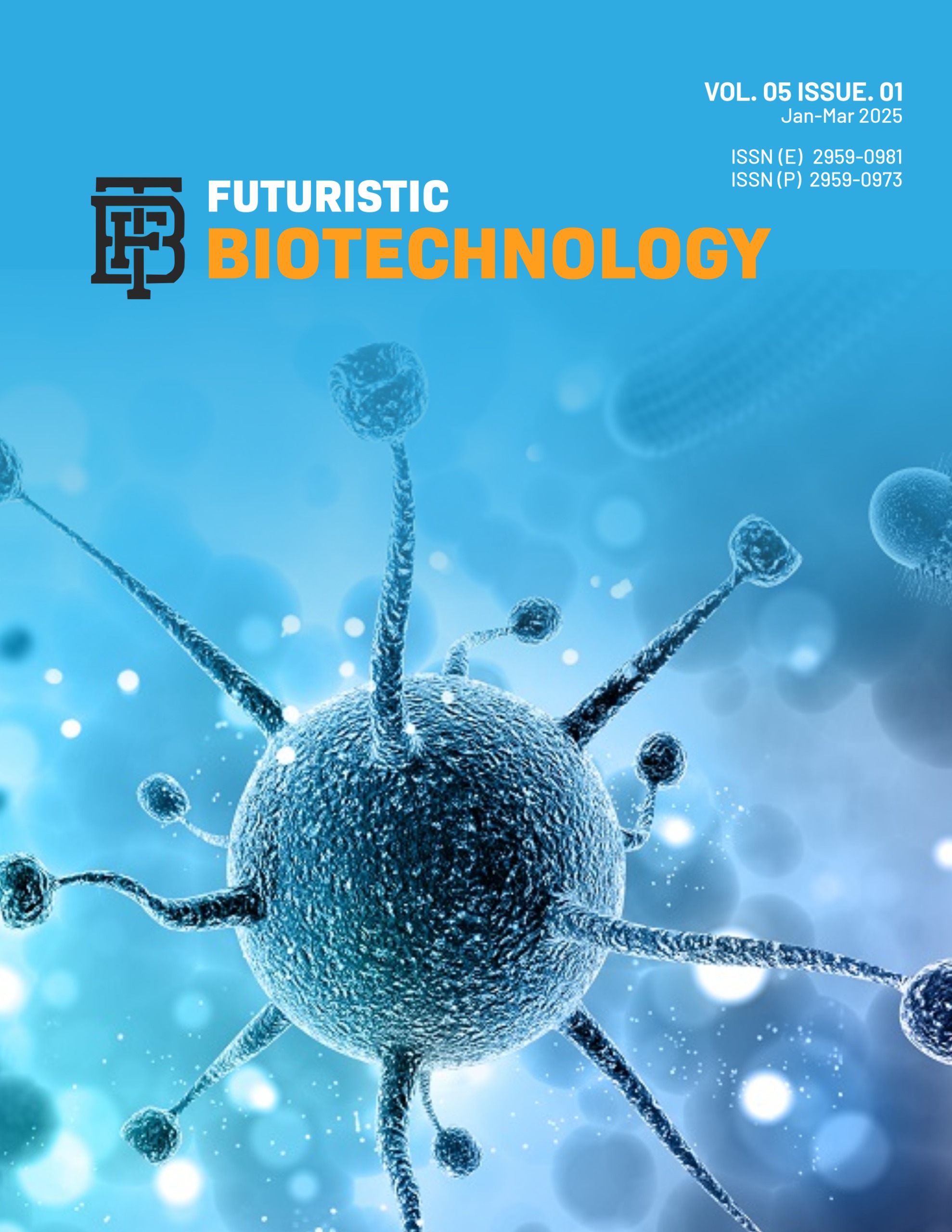The Role of Lifestyle in Modulating the Gut Microbiome
Lifestyle and Gut Microbiome
DOI:
https://doi.org/10.54393/fbt.v5i1.155Keywords:
Gut Microbiome, Gut Brain Axis, Life Style, Microbial Diversity, Societal ImpactAbstract
The human gut, a dynamic and diverse ecosystem of trillions of microorganisms, plays an essential role in the host's health and disease. This review explores the influence of lifestyle choices like diet, stress, physical activity, and environmental factors on gut microbiome and their broader societal implications. Studies have reported that plant-based and Mediterranean diets enhance microbial diversity. At the same time, a sedentary lifestyle, chronic stress, processed foods, and alcohol consumption badly impact on the gut microbial composition and lead to many diseases like dysbiosis, obesity, and cardiovascular diseases. Geographic and ethnic factors also influence the gut microbiome. The consumption of fermented food and a diet high in fiber has a positive impact on the gut microbiome. The gut microbiome also has many societal implications, and the targeted intervention can help to reduce economic losses and public health costs and improve the overall health of everyone. This comprehensive review focuses on the links between lifestyle, gut microbiome, and societal well-being and suggests integrative strategies to promote sustainable health practices.
References
Thursby E and Juge N. Introduction to the Human Gut Microbiota. Biochemical Journal. 2017; 474(11): 1823-36. doi:10.1042/bcj20160510.
Aoun A, Darwish F, Hamod N. The Influence of the Gut Microbiome on Obesity in Adults and the Role of Probiotics, Prebiotics, and Synbiotics for Weight Loss. Preventive Nutrition and Food Science. 2020; 25(2): 113-23. doi:10.3746/pnf.2020.25.2.113.
Sacks D, Baxter B, Campbell B, Carpenter J, Cognard C, Dippel D, et al. Multisociety Consensus Quality Improvement Revised Consensus Statement for Endovascular Therapy of Acute Ischemic Stroke. Journal of Vascular and Interventional Radiology. 2018; 29(4): 441-53. doi: 10.1016/j.jvir.2017.11.026.
Valdes AM, Walter J, Segal E, Spector TD. Role of the Gut Microbiota in Nutrition and Health. BMJ (British Medical Journal). 2018; 361: k2179. doi:10.1136/bmj.k2179.
Org E, Blum Y, Kasela S, Mehrabian M, Kuusisto J, Kangas AJ, et al. Relationships Between Gut Microbiota, Plasma Metabolites, and Metabolic Syndrome Traits in the METSIM Cohort. Genome Biology. 2017; 18: 70. doi:10.1186/s13059-017-1194-2.
Liaqat I, Muhammad N, Mubin M, Arshad N, Iftikhar T, Sajjad S, et al. Antibacterial and Larvicidal Activity of Ethyl Acetate Extract of Actinomycetes from Soil Samples. Pakistan Journal of Zoology. 2023; 55(6): 2065-74. doi: 10.17582/journal.pjz/20200526130518.
Belkaid Y, Hand TW. Role of the Microbiota in Immunity and Inflammation. Cell. 2014; 157(1): 121-41. doi:10.1016/j.cell.2014.03.011.
Noverr MC, Huffnagle GB. Does the Microbiota Regulate Immune Responses Outside the Gut? Trends in Microbiology. 2004; 12(12): 562-8. doi: 10.1016/j.tim.2004.10.008.
David LA, Maurice CF, Carmody RN, Gootenberg DB, Button JE, Wolfe BE, et al. Diet Rapidly and Reproducibly Alters the Human Gut Microbiome. Nature. 2014; 505(7484): 559-63. doi:10.1038/nature12820.
Lee S, Sung J, Lee J, Ko G. Comparison of the Gut Microbiotas of Healthy Adult Twins Living in South Korea and the United States. Applied and Environmental Microbiology. 2011; 77(20): 7433-7. doi:10.1128/AEM.05490-11.
Deschasaux M, Bouter KE, Prodan A, Levin E, Groen AK, Herrema H, et al. Depicting the Composition of Gut Microbiota in a Population with Varied Ethnic Origins but Shared Geography. Nature Medicine. 2018; 24(10): 1526-31. doi:10.1038/s41591-018-0160-1.
Rothschild D, Weissbrod O, Barkan E, Kurilshikov A, Korem T, Zeevi D, et al. Environment Dominates Over Host Genetics in Shaping Human Gut Microbiota. Nature. 2018; 555(7695): 210-5. doi:10.1038/nature25973.
Vangay P, Johnson AJ, Ward TL, Al-Ghalith GA, Shields-Cutler RR, Hillmann BM, et al. US Immigration Westernizes the Human Gut Microbiome. Cell. 2018; 175(4): 962-72. e10. doi: 10.1016/j.cell.2018.10.029.
Mulasi-Pokhriyal U, Smith C, Franzen-Castle L. Investigating Dietary Acculturation and Intake Among US-Born and Thailand/Laos-Born Hmong American Children Aged 9-18 Years. Public Health Nutrition. 2012; 15(1): 176-85. doi:10.1017/S1368980011001649.
Kates AE, Jarrett O, Skarlupka JH, Sethi A, Duster M, Watson L, et al. Household Pet Ownership and the Microbial Diversity of the Human Gut Microbiota. Frontiers in Cellular and Infection Microbiology. 2020; 10: 73. doi:10.3389/fcimb.2020.00073.
Tun HM, Konya T, Takaro TK, Brook JR, Chari R, Field CJ, et al. Exposure to Household Furry Pets Influences the Gut Microbiota of Infants at 3-4 Months Following Various Birth Scenarios. Microbiome. 2017; 5(1): 40. doi:10.1186/s40168-017-0254-x.
Donati Zeppa S, Agostini D, Gervasi M, Annibalini G, Amatori S, Ferrini F, et al. Mutual Interactions Among Exercise, Sport Supplements, and Microbiota. Nutrients. 2020; 12(1): 17. doi:10.3390/nu12010017.
Hughes RL and Holscher HD. Fueling Gut Microbes: A Review of the Interaction Between Diet, Exercise, and the Gut Microbiota in Athletes. Advances in Nutrition. 2021; 12(6): 2190-215. doi:10.1093/advances/nmab077.
Keohane DM, Woods T, O'Connor P, Underwood S, Cronin O, Whiston R, et al. Four Men in a Boat: Ultra-Endurance Exercise Alters the Gut Microbiome. Journal of Science and Medicine in Sport. 2019; 22(9): 1059-64. doi: 10.1016/j.jsams.2019.04.004.
Scheiman J, Luber JM, Chavkin TA, MacDonald T, Tung A, Pham L-D, et al. Meta-Omics Analysis of Elite Athletes Identifies a Performance-Enhancing Microbe That Functions via Lactate Metabolism. Nature Medicine. 2019; 25(7): 1104-9. doi:10.1038/s41591-019-0485-4.
Morita H, Kano C, Ishii C, Kagata N, Ishikawa T, Hirayama A, et al. Bacteroides uniformis and Its Preferred Substrate, Cyclodextrin, Enhance Endurance Exercise Performance in Mice and Human Males. Science Advances. 2023; 9(4): eadd2120. doi:10.1126/sciadv. add2120.
Marttinen M, Ala-Jaakkola R, Laitila A, Lehtinen MJ. Gut Microbiota, Probiotics and Physical Performance in Athletes and Physically Active Individuals. Nutrients. 2020; 12(10): 2936. doi:10.3390/nu12102936.
Turnbaugh PJ, Ridaura VK, Faith JJ, Rey FE, Knight R, Gordon JI. The Effect of Diet on the Human Gut Microbiome: A Metagenomic Analysis in Humanized Gnotobiotic Mice. Science Translational Medicine. 2009; 1(6): 6ra14. doi:10.1126/scitranslmed.3000322.
Wu GD, Chen J, Hoffmann C, Bittinger K, Chen Y-Y, Keilbaugh SA, et al. Linking Long-Term Dietary Patterns with Gut Microbial Enterotypes. Science. 2011; 334(6052): 105-8. doi:10.1126/science.1208344.
Ma C-L, Ma X-T, Wang J-J, Liu H, Chen Y-F, Yang Y. Physical Exercise Induces Hippocampal Neurogenesis and Prevents Cognitive Decline. Behavioural Brain Research. 2017; 317: 332-9. doi: 10.1016/j.bbr.2016.09.067.
Dao MC, Everard A, Aron-Wisnewsky J, Sokolovska N, Prifti E, Verger EO, et al. Akkermansia muciniphila and Improved Metabolic Health During a Dietary Intervention in Obesity: Relationship with Gut Microbiome Richness and Ecology. Gut. 2016; 65(3): 426-36. doi:10.1136/gutjnl-2014-308778.
Lukovac S, Belzer C, Pellis L, Keijser BJ, de Vos WM, Montijn RC, et al. Differential Modulation by Akkermansia muciniphila and Faecalibacterium prausnitzii of Host Peripheral Lipid Metabolism and Histone Acetylation in Mouse Gut Organoids. mBio. 2014; 5(4): e01438-14. doi:10.1128/mBio.01438-14.
Ma D, Wang AC, Parikh I, Green SJ, Hoffman JD, Chlipala G, et al. Ketogenic Diet Enhances Neurovascular Function with Altered Gut Microbiome in Young Healthy Mice. Scientific Reports. 2018; 8(1): 6670. doi:10.1038/s41598-018-25190-5.
Olson CA, Vuong HE, Yano JM, Liang QY, Nusbaum DJ, Hsiao EY. The Gut Microbiota Mediates the Anti-Seizure Effects of the Ketogenic Diet. Cell. 2018; 173(7): 1728-41. e13. doi: 10.1016/j.cell.2018.04.027.
Swidsinski A, Dörffel Y, Loening-Baucke V, Gille C, Göktas Ö, Reißhauer A, et al. Reduced Mass and Diversity of the Colonic Microbiome in Patients with Multiple Sclerosis and Their Improvement with Ketogenic Diet. Frontiers in Microbiology. 2017; 8: 1141. doi:10.3389/fmicb.2017.01141.
Shimizu H, Tosaki T, Kanai Y, Hishikawa Y, Ohta K, Seino S. Insulin-Induced Apoptosis and Involvement of the Forkhead Transcription Factor FKHR. Diabetes. 1999; 48(2): 407-13. doi:10.2337/diabetes.48.2.407.
Brunet A, Bonni A, Zigmond MJ, Lin MZ, Juo P, Hu LS, et al. Akt Promotes Cell Survival by Phosphorylating and Inhibiting a Forkhead Transcription Factor. Cell. 1999; 96(6): 857-68. doi:10.1016/s0092-8674(00)80595-4.
van der Horst A, Burgering BM. Stressing the Role of FoxO Proteins in Lifespan and Disease. Nature Reviews Molecular Cell Biology. 2007; 8(6): 440-50. doi:10.1038/nrm2190.
Gross DN, van den Heuvel AP, Birnbaum MJ. The Role of FoxO in the Regulation of Metabolism. Oncogene. 2008; 27(16): 2320-36. doi:10.1038/sj.onc.1210950.
Eijkelenboom A, Burgering BM. FOXOs: Signalling Integrators for Homeostasis Maintenance. Nature Reviews Molecular Cell Biology. 2013; 14(2): 83-97. doi:10.1038/nrm3507.
Webb AE, Brunet A. FOXO Transcription Factors: Key Regulators of Cellular Quality Control. Trends in Biochemical Sciences. 2014; 39(4): 159-69. doi:10.1016/j.tibs.2014.02.003.
Dansen TB, Smits LM, van Triest MH, de Keizer PL, Vries-Smits AM, Burgers PP, et al. Redox-Sensitive Cysteine Residues in the Forkhead Transcription Factor FoxO4 Regulate PKB-Mediated Phosphorylation. Proceedings of the National Academy of Sciences of the United States of America. 2009; 106(27): 9240-5. doi:10.1073/pnas.0900423106.
Hedrick SM. The Acquired Immune System: A Vantage from Beneath. Immunity. 2004; 21(6): 607-10. doi:10.1016/j.immuni.2004.10.008.
Ouyang W, Li MO. Foxo: In Command of T Lymphocyte Homeostasis and Tolerance. Trends in Immunology. 2011; 32(1): 26-33. doi:10.1016/j.it.2010.11.002.
Dejean AS, Beisner DR, Ch'en IL, Kerdiles YM, Babour A, Arden KC, et al. Transcription Factor FoxO3 Controls the Generation of Memory CD8+ T Cells by Regulating Proliferation in Response to IL-15. Proceedings of the National Academy of Sciences of the United States of America. 2009; 106(48): 20121-6. doi:10.1073/pnas.0906357106.
Kerdiles YM, Beisner DR, Tinoco R, Dejean AS, Castrillon DH, DePinho RA, et al. Foxo1 Links Homing and Survival of Naive T Cells by Regulating L-Selectin, CCR7 and Interleukin 7 Receptor. Nature Immunology. 2009; 10(2): 176-84. doi:10.1038/ni.1689.
Ouyang W, Liao W, Luo CT, Yin N, Huse M, Kim MV, et al. Novel Foxo1-Dependent Transcriptional Programs Control T Regulatory Cell Function. Nature. 2012; 491(7425): 554-9. doi:10.1038/nature11581.
Kim MV, Ouyang W, Liao W, Zhang MQ, Li MO. The Transcription Factor Foxo1 Controls Central-Memory CD8+ T Cell Responses to Infection. Immunity. 2013; 39(2): 286-97. doi:10.1016/j.immuni.2013.07.013.
Scott-Browne JP, Lopez-Moyado IF, Trifari S, Wong V, Chavez L, Rao A, et al. Dynamic Changes in Chromatin Accessibility Occur in CD8+ T Cells Responding to Viral Infection. Immunity. 2016; 45(6): 1327-40. doi:10.1016/j.immuni.2016.10.028.
Seoane J, Le HV, Shen L, Anderson SA, Massagué J. Integration of Smad and Forkhead Pathways in the Control of Neuroepithelial and Glioblastoma Cell Proliferation. Cell. 2004; 117(2): 211-23. doi:10.1016/s0092-8674(04)00302-3.
Essaghir A, Dif N, Marbehant CY, Coffer PJ, Demoulin JB. The Transcription of FOXO Genes Is Stimulated by FOXO3 and Repressed by Growth Factors. The Journal of Biological Chemistry. 2009; 284(16): 10334-42. doi:10.1074/jbc.M807114200.
Iyer AK, Azad N, Wang L, Rojanasakul Y. Role of Reactive Oxygen Species and Nitric Oxide in the Mechanism of Apoptosis Induced by Aflatoxin B1 in HepG2 Cells. Free Radical Biology and Medicine. 2008; 44(7): 1224-31. doi:10.1016/j.freeradbiomed.2007.11.018.
Zhang Y, Gan B, Liu D, Paik JH. FoxO Family Members in Cancer. Cancer Biology & Therapy. 2011; 12(4): 253-9. doi:10.4161/cbt.12.4.16014.
Manning BD, Toker A. AKT/PKB Signaling: Navigating the Network. Cell. 2017; 169(3): 381-405. doi:10.1016/j.cell.2017.04.001.
Greer EL, Brunet A. FOXO Transcription Factors at the Interface Between Longevity and Tumor Suppression. Oncogene. 2005; 24(50): 7410-25. doi:10.1038/sj.onc.1209086.
Arden KC. Multiple Roles of FOXO Transcription Factors in Mammalian Cells Point to Multiple Roles in Cancer. Experimental Gerontology. 2006; 41(8): 709-17. doi:10.1016/j.exger.2006.06.040.
Martinez-Garcia V, Ayllon V, Garcia-Olmo DC, Torres-Ruiz R, Garcia-Olmo D, Kremer L, et al. The Emerging Role of FOXO Transcription Factors in Pancreatic Beta Cells. Journal of Molecular Endocrinology. 2016; 56(1): R35-50. doi:10.1530/JME-15-0114.
Kenyon C. The Plasticity of Aging: Insights from Long-Lived Mutants. Cell. 2005; 120(4): 449-60. doi:10.1016/j.cell.2005.02.002.
Lin K, Dorman JB, Rodan A, Kenyon C. daf-16: An HNF-3/Forkhead Family Member That Can Function to Double the Lifespan of Caenorhabditis Elegans. Science. 1997; 278(5341): 1319-22. doi:10.1126/science.278.5341.1319.
Hwangbo DS, Gershman B, Tu MP, Palmer M, Tatar M. Drosophila dFOXO Controls Lifespan and Regulates Insulin Signalling in Brain and Fat Body. Nature. 2004; 429(6991): 562-6. doi:10.1038/nature02549.
Yamamoto R, Tatar M. Insulin Receptor Substrate Chico Acts with the Transcription Factor FOXO to Extend Lifespan in Drosophila. Mechanisms of Ageing and Development. 2011; 132(10): 468-79. doi: 10.1016/j.mad.2011.10.003.
Alic N, Hoddinott MP, Vinti G, Partridge L. Lifespan Extension by Increased Expression of the Drosophila Homolog of the Mammalian Forkhead Transcription Factor FOXO Is Dependent on Insulin Receptor Substrate chico. Aging Cell. 2011; 10(4): 729-32. doi:10.1111/j.1474-9726.2011.00706.x.
Martins R, Lithgow GJ, Link W. Long Live FOXO: Unraveling the Role of FOXO Proteins in Aging and Longevity. Aging Cell. 2016; 15(2): 196-207. doi:10.1111/acel.12427.
Weigel D, Jürgens G, Küttner F, Seifert E, Jäckle H. The Homeotic Gene Fork Head Encodes a Nuclear Protein and Is Expressed in the Terminal Regions of the Drosophila Embryo. Cell. 1989; 57(4): 645-58. doi:10.1016/0092-8674(89)90134-2.
Kaestner KH, Knochel W, Martinez DE. Unified Nomenclature for the Winged Helix/Forkhead Transcription Factors. Genes & Development. 2000; 14(2): 142-6. doi:10.1101/gad.14.2.142.
Hannenhalli S, Kaestner KH. The Evolution of Fox Genes and Their Role in Development and Disease. Nature Reviews Genetics. 2009; 10(4): 233-40. doi:10.1038/nrg2523.
Arden KC. FOXO Animal Models Reveal a Variety of Diverse Roles for FOXO Transcription Factors. Oncogene. 2007; 27(16): 2345-50. doi: 10.1038/sj.onc.1210951.
Mahmud DL, Plesner A, Nielsen MD, Flyvbjerg A, Kristiansen SB, Andersen CL, et al. Forkhead Box O Transcription Factors Are Essential Regulators of Proangiogenic Vascular Endothelial Growth Factor-A Signaling in Endothelial Cells and Neovascularization in Mice. Journal of Biological Chemistry. 2014; 289(34): 23677-88. doi:10.1074/jbc.M114.570085.
Gan B, Lim C, Chu G, Hua S, Ding Z, Collins M, et al. FoxOs Enforce a Progression Checkpoint to Restrict Differentiation of Tumor Cells. Cell. 2010; 141(5): 749-60. doi:10.1016/j.cell.2010.03.041.
Nakae J, Kitamura T, Silver DL, Accili D. The Forkhead Transcription Factor Foxo1 (Fkhr) Confers Insulin Sensitivity to Adipocytes. Journal of Clinical Investigation. 2001; 108(9): 1359-67. doi:10.1172/JCI12852.
Kitamura T, Kahn CR, Accili D. Insulin Receptor Knockout Mice. Annual Review of Physiology. 2003; 65: 313-32. doi: 10.1146/annurev.physiol.65.092101.142540.
Paik JH, Kollipara R, Chu G, Ji H, Xiao Y, Ding Z, et al. FoxOs Are Lineage-Restricted Redundant Tumor Suppressors and Regulate Endothelial Cell Homeostasis. Cell. 2007; 128(2): 309-23. doi: 10.1016/j.cell.2006.12.029.
Rached MT, Kode A, Xu L, Yoshikawa Y, Paik JH, DePinho RA, et al. FoxO Transcription Factors Maintain Osteoblast Differentiation and Protect Against Glucocorticoid-Induced Oxidative Stress. Cell Metabolism. 2010; 11(2): 147-60. doi: 10.1016/j.cmet.2010.01.002.
Salih DA, Brunet A. FOXO Transcription Factors in the Maintenance of Cellular Homeostasis During Aging. Current Opinion in Cell Biology. 2008; 20(2): 126-36. doi: 10.1016/j.ceb.2008.02.005.
Gomis RR, Alarcón C, Nadal C, Van Poznak C, Massagué J. C/EBPβ at the Core of the TGFβ Cytostatic Response and Its Evasion in Metastatic Breast Cancer Cells. Cancer Cell. 2006; 10(3): 203-14. doi: 10.1016/j.ccr.2006.08.001.
Singh A, Joyner AL. Sonic Hedgehog Signaling Development of the Nervous System. Development. 2019; 146(12): dev176736. doi:10.1242/dev.176736.
Rhinn M, Dollé P. Retinoic Acid Signalling in Development. Development. 2012; 139(5): 843-58. doi:10.1242/dev.065938.
Zhang Y, Gan B, Liu D, Paik JH. FoxO Family Members in Cancer. Cancer Biology & Therapy. 2011; 12(4): 253-9. doi:10.4161/cbt.12.4.16014.
Daitoku H, Sakamaki J, Fukamizu A. Regulation of FoxO Transcription Factors by Acetylation and Protein-Protein Interactions. Biochimica et Biophysica Acta. 2011; 1813(11): 1954-60. doi: 10.1016/j.bbamcr.2010.09.002.
Greer EL, Brunet A. FOXO Transcription Factors in Ageing and Cancer. Acta Physiologica. 2008; 192(1): 19-28. doi:10.1111/j.1748-1716.2007.01785.x.
Huang H, Tindall DJ. Regulation of FoxO Protein Stability via Ubiquitination and Proteasome Degradation. Biochimica et Biophysica Acta. 2011; 1813(11): 1961-4. doi:10.1016/j.bbamcr.2010.09.007.
Furuyama T, Nakazawa T, Nakano I, Mori N. Identification of the Differential Distribution Patterns of mRNAs and Consensus Binding Sequences for Mouse DAF-16 Homologs. Biochemical and Biophysical Research Communications. 2000; 272(2): 587-92. doi:10.1006/bbrc.2000.2792.
Accili D, Arden KC. FoxOs at the Crossroads of Cellular Metabolism, Differentiation, and Transformation. Cell. 2004; 117(4): 421-6. doi:10.1016/s0092-8674(04)00452-0.
Lee S, Dong HH. FoxO Integration of Insulin Signalling with Glucose and Lipid Metabolism. Journal of Endocrinology. 2017; 233(2): R67-79. doi:10.1530/JOE-16-0495.
Obsil T, Obsilova V. Structural Basis for DNA Recognition by FOXO Proteins. Biochimica et Biophysica Acta. 2011; 1813(11): 1946-53. doi: 10.1016/j.bbamcr.2010.12.029.
Li H, Jogl G. Structural and Functional Insight into Insulin Regulation of FOXO Transcription Factors. Current Biology. 2009; 19(24): 2156-62. doi: 10.1016/j.cub.2009.10.080.
Maiese K, Chong ZZ, Shang YC, Wang S. Targeting Disease Through Novel Pathways of Apoptosis and Autophagy. Expert Opinion on Therapeutic Targets. 2012; 16(2): 120-8. doi:10.1517/14728222.2011.643299.
Huang H, Tindall DJ. Regulation of FOXO Protein Stability via Ubiquitination and Proteasome Degradation. Biochimica et Biophysica Acta. 2011; 1813(11): 1961-4. doi: 10.1016/j.bbamcr.2010.09.007.
Accili D, Arden KC. FoxOs at the Crossroads of Cellular Metabolism. Cell. 2004; 117(4): 421-6. doi:10.1016/s0092-8674(04)00452-0.
Downloads
Published
How to Cite
Issue
Section
License
Copyright (c) 2025 Futuristic Biotechnology

This work is licensed under a Creative Commons Attribution 4.0 International License.
This is an open-access journal and all the published articles / items are distributed under the terms of the Creative Commons Attribution License, which permits unrestricted use, distribution, and reproduction in any medium, provided the original author and source are credited. For comments editor@fbtjournal.com












